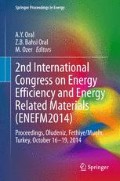Abstract
Lawsonia Inermis, known as Henna, is a widely used product for cosmetic and medicinal purposes in many countries. It is native to tropical and subtropical regions of Africa, southern Asia, and northern Australia. Although Henna is widely used; it has been shown to cause oxidative hemolysis, especially in people with glucose-6-phosphate dehydrogenase deficiency. The objective of this study was to determine whether henna is light sensitive or not and to examine the effect of henna seed extract and henna powder on osmotic fragility of blood cells. Henna seeds were extracted using a microwave-assisted extraction method. The effect of henna seed and powder was tested on red blood cells (RBCs) with three different NaCl concentrations. Henna seed extraction increased hemolysis rate, meanwhile, henna powder did not affect hemolysis even at high NaCl concentration. This suggests that henna powder is not sensitive to sunlight. Our results suggest that the seed extraction of Lawsonia inermis could be potentially used as a protective agent as well as a sunscreen substitute.
Access this chapter
Tax calculation will be finalised at checkout
Purchases are for personal use only
References
M.S. Lavhate, S.H. Mishra, A review: nutritional and therapeutic potential of Ailanthus excelsa. Pharmacog. Re. 1, 105–113 (2007)
Abdelraouf, A. Amany, A. Nedaa, Antibacterial, antifungal and synergistic effect of Lawsonia inermis, Punicagranatum and Hibiscus sabdariffa. Ann. Alquds Med. (7), 33–41 (2011)
R. Hema, S. Kumaravel, N. Gomathi, Gas chromatography mass spectroscopic analysis of Lawsonia inermis Leaves. NY Sci. J. 3(12), 99–101 (2010)
P. Arun, K.G. Purushotham, J. Jayarani, V. Kumari, In vitro Antibacterial activity and Flavonoid contents of Lawsonia inermis (Henna). Int. J. Pharm. Technol. Res. 2(2), 1178–1181 (2010)
F.R. Gallo, G. Multari, G. Palazzino, G. Pagliuca, M.M. Zadeh, P.N. Biapa, M. Nicoletti, Henna through the centuries: a quick HPTLC analysis proposal to check henna identity. Rev. Bras Farmacogn. 24, 133–140 (2014)
K. Reddy, Folk medicine from Chittoor District Andhra Pradesh, India used in the treatment of jaundice. International Journal Crude Drug Research. 26(3), 137–140 (1988)
K. Chetty, Flowering Plants of Chittoor, 1st edn. (Andhra Pradesh, 2008)
I. Perinet, E. Lioson, L. Tichadou, M. Glaizal, L. de Haro, Hemolytic anemia after voluntary ingestion of henna (Lawsonia inermis) decoction by a young girl with G6PD deficiency. Med. Trop. (Mars). 71(3), 292–294 (2011)
A. Vander, J. Sherman, D. Luciano, E. Widmaier, H. Raff, H. Strang, Human Physiology-the Mechanism of Body Function, 8th edn. (McGraw-Hill Education, 2001), pp. 132–144
H. Chang, S.E. Suzuka, Lawsone (2-OH-1,4-naphthoquinone) derived from the henna plant increases the oxygen affinity of sickle cell blood. Biochem. Biophys. Res. Commun. 107(2), 602–608 (1982)
D. McMillan, S. Sarvate, J. Oatis, J. Jollow, Role of oxidant stress in Lawsone-induced hemolytic anemis. Toxicol. Sci. 82, 647–655 (2004)
Archives of Pharmacal Research, Natural Medicines Comprehensive Database (2001), pp. 431–436. www.naturaldatabase.com
Acknowledgments
This work was supported by a grant from the Deanship of Scientific Research at Jordan University of Science and Technology (JUST) No. 7/2014.
Author information
Authors and Affiliations
Corresponding author
Editor information
Editors and Affiliations
Rights and permissions
Copyright information
© 2015 Springer International Publishing Switzerland
About this paper
Cite this paper
Alkhatib, R., Al-Akhras, MA., Al-Khalili, D.J. (2015). Solar Irradiation on Lawsonia Inermis Sensitized with Red Blood Cells: Effect on Osmotic Fragility. In: Oral, A., Bahsi Oral, Z., Ozer, M. (eds) 2nd International Congress on Energy Efficiency and Energy Related Materials (ENEFM2014). Springer Proceedings in Energy. Springer, Cham. https://doi.org/10.1007/978-3-319-16901-9_12
Download citation
DOI: https://doi.org/10.1007/978-3-319-16901-9_12
Published:
Publisher Name: Springer, Cham
Print ISBN: 978-3-319-16900-2
Online ISBN: 978-3-319-16901-9
eBook Packages: EnergyEnergy (R0)

